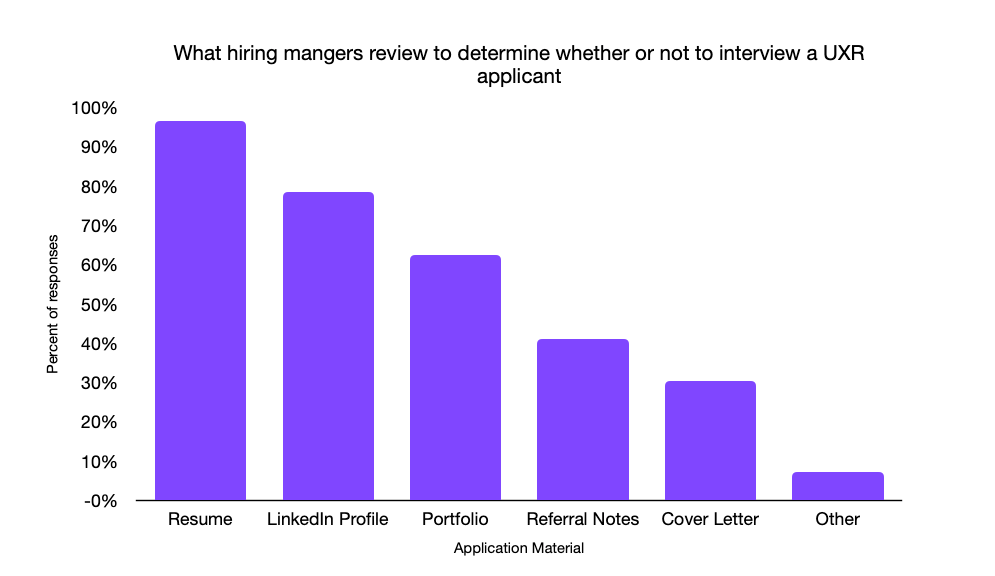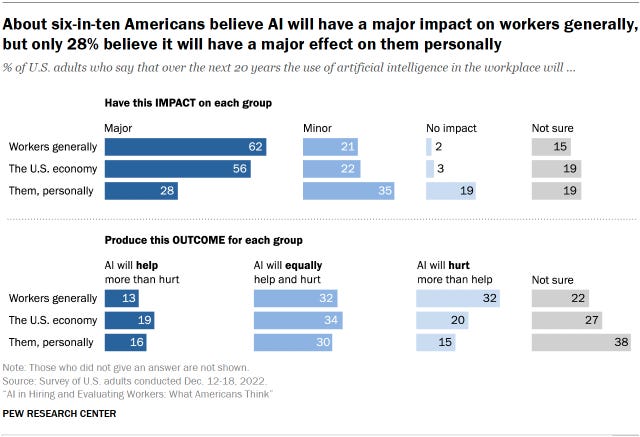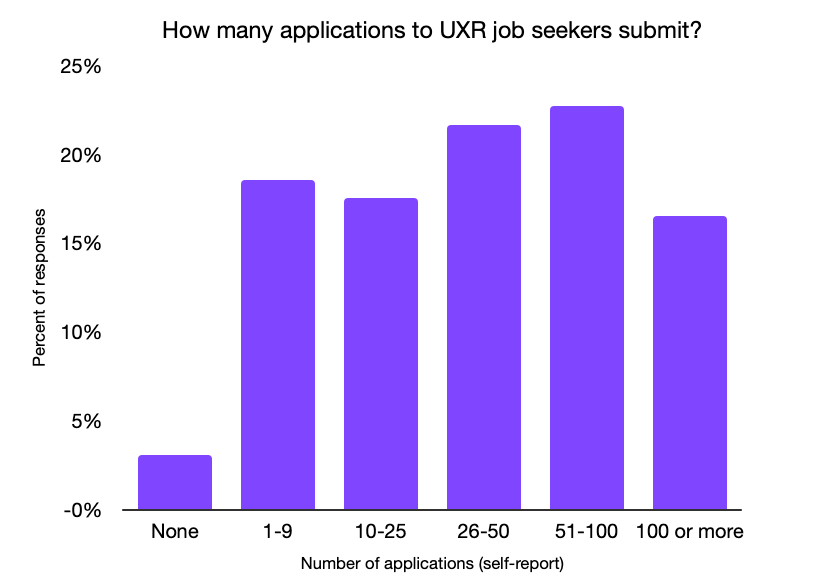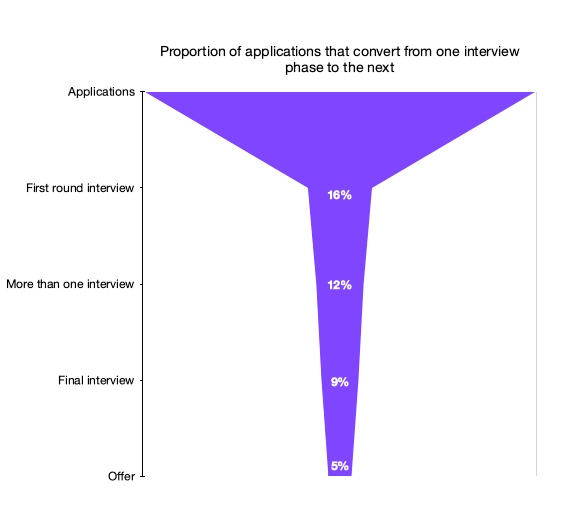How many UX research jobs should I apply to? How many will turn into interviews?
Plus six other questions you've had about UXR interviews
Job seeking can be an uncertain, and sometimes anxiety-producing journey. Naturally, candidates have many questions about the process, what’s normal, and what to expect.
Since sharing our findings1 on UXR job interviews and hiring processes we’ve been fielding many questions. Folks are clearly passionate and interested in this topic, and we appreciate the enthusiastic response. In this issue, we will expand on our answers to some common questions.
What are the most common ways to find UXR jobs? Which are the most effective?
In our research, we see that LinkedIn and job boards produce the most job leads, while referrals yield the highest quality leads.
LinkedIn is the primary resource for the vast majority of job-seekers due to its ease of use and networking features. Job boards like Indeed are also frequently used, but secondary to LinkedIn.
Referrals, although infrequent, are the most effective way to find high-quality job leads. Industry stats show they may be up to 4x more likely to be hired, and tend to stay in roles longer than non-referred hires.
“The best way to get your resume seen is to have that referral from somebody…to network and know people” -Job-seeking participant
Participants rarely visited company career pages. This was the least common form of job searching and was usually reserved for one to three companies on a target list.
If you’re looking for UX jobs, LinkedIn and sites like Indeed will be a useful go-to for finding openings, but the best way to increase your chances of landing interviews is to leverage your connections. This is a great reminder that we should all be networking frequently.
“I think networking is the most important thing for people if they're trying to get into UX or find their new UX role.” -Job-seeking participant
What key information do job-seekers look for in UXR job descriptions?
Job-seekers expressed dissatisfaction with the generic nature of job descriptions — because of this, several have developed the habit of not thoroughly reading JDs. As one participant put it, “I'm not really reading the job descriptions a whole lot because I feel like they all say the same thing.”
What these job-seekers tend to read for are signals that indicate the focus of the role, acknowledging that different positions have different levels of emphasis on research vs. other skills.
“Some UX research roles are design roles; some are strategy roles, and some are more ops roles. Not all research roles are straight research. I'm okay with that, but generic job ads don't help me narrow down which roles I ended up applying to.“ -Job-seeking participant
All the more reason why hiring managers should tailor their job descriptions to reflect the duties and responsibilities the candidate will fulfill in the position.
How many applications do people submit? How many turn into interviews?
Landing a job can feel like a numbers game. Many wonder how many applications job-seekers typically submit, and how many turn into interviews.
In our sample, over 60% of job-seekers had submitted 25 or more applications. Those who are actively looking are quite active. However, the funnel from one interview stage to the next can look rather bleak.
The selection process eliminates most applicants early; relatively few applications turn into first-round interviews (about 16%). From there, some candidates are excused after one or more interviews, until about 5% receive an offer. So, on average you would expect to see one job offer per 20 applications, but that ratio can vary drastically by the individual.
Our data shows that applicants with more experience, and those who submit fewer applications, have a higher conversion rate from application to interview. Job experience can make a candidate more qualified, so their success makes sense. The finding that fewer applications yields a higher conversion rate may seem counterintuitive, but candidates who submit relatively few applications may be employing different strategies than those who submit many (e.g., selectively applying & leveraging connections vs. playing the numbers game).
We hope these data may help job-seekers understand what to expect from their search.
Which materials do hiring managers look at to decide who to interview?
Many job-seekers we spoke with expressed frustration with not knowing which application materials hiring managers review, making it difficult to prioritize their time and maximize their success.
“Please make it clear if a cover letter is expected or not. These 'optional' cover letters are so confusing. Will you even read it? Is it worth my time? Back in the day, I know they mattered but now I have no idea. I've heard recruiters don't even look at them... but then why is it an option? And why is it optional? Will it look bad if I don't submit one? I just have no idea.” -Job-seeking participant
Our data showed a clear hierarchy for what materials get looked at. Almost all hiring managers review resumes and/or LinkedIn profiles. Many review portfolios; if they ask for them at the application stage, they will likely evaluate your portfolio before interviewing you. Less than half read referral notes, and only about one-quarter read cover letters.

This graph should provide job-seekers guidance in prioritizing their efforts.
How do interview cycles for contract positions compare?
Temporary contract UXR positions are common, but interviews for these roles differ from full-time roles. Interview cycles for contract positions are quicker and have fewer rounds than those for FTE roles. Hiring managers often abbreviate their processes for contract positions.
“Depending on the stage of the company, needs of the business, there may be a need to accelerate some activities” - Hiring manager participant
There are a few reasons for these abbreviated processes. Contract positions may need to be filled urgently, which drives a faster timeline. Additionally, HR policies covering contract positions usually don’t require as many interviews or background checks. Finally, hiring a contractor poses less of a commitment and a lower potential downside to the hiring team. The contract period sometimes serves as an extended trial to determine if an applicant should be converted to full-time.
Job-seekers applying to contract positions should prepare for all the usual interview questions but a faster overall process with fewer rounds.
What advice did your participants share?
A recurring theme from our interviews was the importance of two-way vetting. It’s crucial to remember that while a hiring manager is assessing the candidate’s fit for the role, the candidate is also assessing whether they would like to work in this role for this company. Both hiring managers and job-seekers advise others to remember that vetting goes both directions.
“The interview should provide both candidate and company a way to get to know each other…” -Hiring manager participant
For a job-seeker, an interview is a valuable time to assess their fit in the role, team, and company. They can prepare by identifying their priorities, creating a list of questions, and taking notes. For hiring managers, don’t assume a candidate is sold on the role & company because they applied to the position; leave room for the candidate to ask you and your team questions.
How do you see AI impacting hiring in UX?
We have received many questions about the use of AI in hiring & interviewing UXR job candidates. We didn’t specifically ask about AI in our research and none of the hiring managers we interviewed explicitly mentioned leveraging AI in their process. But, AI assistance is likely coming and may already be in use by others involved in hiring (e.g., recruiters).
The Pew Research Center explored Americans' views on the use of artificial intelligence (AI) in workplaces. The survey found that people are generally wary and uncertain about the use of AI in hiring and assessing workers.

We’ve previously written about our thoughts on using AI for UX research and think the principles also apply to using AI tools to hire UX researchers.
The bottom line
We’ve been impressed and delighted by the reaction to this body of research. The UX community is passionate about how we interview and hire for research roles. We hope this FAQ addresses questions you have had in the past; if you have any remaining questions, drop us a line.
A quick question for you
There are a few trends that I’ve been following lately. I’m curious which ones you’re seeing, and what you expect will have the largest impact on our field.
Which of the following do you expect will have the biggest impact on UX in the next two years?
Until next time
Your reactions and perspectives matter to me, and I'd love to hear from you. You can hit reply to share any responses, suggestions, or questions.
As always, thanks for reading & being part of this community.
Cheers,
Thomas
Part 1, Conference talk: How teams hire UX researchers today: A survey of current trends and best practices.
Part 2, Article: What UX Research job interview cycles look like today.
Part 3, Article: What makes UX Research job interviews "horrible?".
Part 4, Article: Building and evaluating UX Research portfolios.








I bet! In the meantime, I guess we have to apply Occam’s Razor and hope that we start to see a broader appreciation of UX’s centrality to truly successful products, rather than just being a cost center, especially from executive-level voices. 🤞
Thank you for this patient and thorough analysis of experiences. Given the poll results so far and the actual positive (?) state of the US economy as described today by Judd Legum (https://open.substack.com/pub/popularinformation/p/if-the-us-economy-is-doing-well-why?r=1kcdc&utm_medium=ios&utm_campaign=post), it would be great to look at the broader reasons why the hiring landscape is so rough right now within the tech sector. Why have so many people been laid off, really, and what are the structural issues currently occluding the sector’s expansion? I expect that the evaporation of cheap money will explain it for some smaller companies but I do wonder about the behavior of larger companies. Are they all being aggressively milked by shareholders right now? Beyond the scope of this newsletter, I know, but a sense of why that landscape is how it is at the moment and the areas that are less prone to such behavior would be so helpful. Anyway, I really appreciate what you’re doing here by looking at the state of the field.